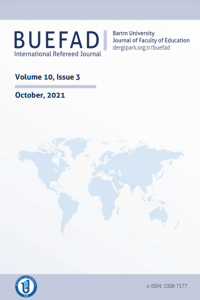Abstract
Araştırmanın amacı, dijital okuryazarlık engelleri (DILBAR)) ölçeğinin geliştirilmesidir. Araştırmanın yöntemi tarama modeli şeklindedir. Uygulamada Türkiye’de Akdeniz Üniversitesi, Bartın Üniversitesi ve Bayburt Üniversitesi’nde bulunan 177 öğrenci ve 101 öğretim üyesi olmak üzere toplam 278 katılımcıyla çalışılmıştır. Faktör analizi sonuçlarına göre, DILBAR ölçeğinin KMO değeri 0,905, Bartlett testi değeri 1023,211’dir (Sd= 55, p=0,000). DILBAR ölçeği tek ve çok boyutlu olarak kullanılabilir. Ölçek, varyansın % 60,113’ünü karşılamaktadır. DILBAR ölçeği için yapılan analiz sonuçlarında, faktör yüklerinin 0,453-0,819 arasında ve madde toplam korelasyonlarının 0.523-0.752 arasında değiştiği görülmektedir. Ölçeğin iki yarı puanları arasındaki korelasyon katsayısı 0,769 bulunmuştur. DILBAR ölçeğinin Cronbach Alpha katsayısı 0,859’dur. Ölçek, 11 maddeden oluşmuştur. Bu sonuçlara bakarak, ölçeğin geçerli ve güvenilir olduğu söylenebilir. Geçerliği ve güvenirliği sağlanmış DILBAR ölçeğinin AMOS programı ile doğrulayıcı faktör analizi yapılmıştır (Kay kare=59,882, Sd=40, GFI=0,965, CFI=0,980, RMSEA=0,042). Bu sonuçlara göre ölçek, üniversite öğrencilerine ve öğretim üyelerine uygulanabilir.
References
- Çubukçu, A. ve Bayzan, ş. (2013). Türkiye’de Dijital Vatandaşlık Algısı ve Bu Algıyı İnternetin Bilinçli, Güvenli ve Etkin Kullanımı ile Artırma Yöntemleri. Middle Eastern & African Journal of Educational Research, 5, 148-174.
- Mohammadyari, S., & Singh, H. (2015). Understanding the effect of e-learning on individual performance: The role of digital literacy. Computers & Education, 82, 11-25.
- Ainley, J., Schulz, W., & Fraillon, J. (2016). A global measure of digital and ICT literacy skills. Global Education Monitoring Report, Education for People and Planet: Creating Sustainable Futures for All.
- Hamutoğlu, N.B.; Canan Güngören, Ö.; Kaya Uyanık, G. ve Gür Erdoğan, D. (2017). Dijital Okuryazarlık Ölçeği: Türkçe ’ye Uyarlama Çalışması. Ege Eğitim Dergisi, (18) 1: 408- 429.
- Ng, W. (2012). Can we teach digital natives digital literacy? Computers & Education, 59, 1065-1078.
- Ng, W. (2012). Can we teach digital natives digital literacy?. Computers & Education, 59(3), 1065-1078.
- Üstündağ, M.T., Güneş, E.,ve Bahçivan, E. (2017). Turkish adaptation of Digital Literacy Scale and investigating pre-service science teachers’ digital literacy. Journal of Education and Future, 12: 19-29.
- Hargittai, E. (2005). Survey measures of web-oriented digital literacy. Social Science Computer Review, 23(3), 371-379.
Abstract
This research aims to develop a digital literacy barriers (DILBAR) scale. The survey method was used. A total of 278 participants, including 177 students and 101 faculty members from Akdeniz University, Bartın University and Bayburt University in Turkey, were included in the study. According to the factor analysis results KMO value of DILBAR scale is 0.905 and the value of Barlett’s test is 1023,211 (Df= 55, p=0,000). The DILBAR scale can be used in single and multidimensional forms. The scale explains 60,113% of the total variance. In the analysis results for DILBAR scale, it is seen that the factor loads vary between 0.453-0.819 and the item-total correlations vary between 0.523-0.752. The correlation coefficient between the two halves of the scale was 0.769. The Cronbach’s Alpha Coefficient of DILBAR scale is 0.859. The scale consists of 11 items. In line with these results, the scale can be said to be valid and reliable. After its validity and reliability were ensured, confirmatory factor analysis of the DILBAR scale was performed with the AMOS program. (Chi-square = 59,882, Df = 40, GFI = 0,965, CFI = 0,980, RMSEA = 0.042). As the results suggest, the scale is valid and reliable and can be applied to university students and faculty members.
References
- Çubukçu, A. ve Bayzan, ş. (2013). Türkiye’de Dijital Vatandaşlık Algısı ve Bu Algıyı İnternetin Bilinçli, Güvenli ve Etkin Kullanımı ile Artırma Yöntemleri. Middle Eastern & African Journal of Educational Research, 5, 148-174.
- Mohammadyari, S., & Singh, H. (2015). Understanding the effect of e-learning on individual performance: The role of digital literacy. Computers & Education, 82, 11-25.
- Ainley, J., Schulz, W., & Fraillon, J. (2016). A global measure of digital and ICT literacy skills. Global Education Monitoring Report, Education for People and Planet: Creating Sustainable Futures for All.
- Hamutoğlu, N.B.; Canan Güngören, Ö.; Kaya Uyanık, G. ve Gür Erdoğan, D. (2017). Dijital Okuryazarlık Ölçeği: Türkçe ’ye Uyarlama Çalışması. Ege Eğitim Dergisi, (18) 1: 408- 429.
- Ng, W. (2012). Can we teach digital natives digital literacy? Computers & Education, 59, 1065-1078.
- Ng, W. (2012). Can we teach digital natives digital literacy?. Computers & Education, 59(3), 1065-1078.
- Üstündağ, M.T., Güneş, E.,ve Bahçivan, E. (2017). Turkish adaptation of Digital Literacy Scale and investigating pre-service science teachers’ digital literacy. Journal of Education and Future, 12: 19-29.
- Hargittai, E. (2005). Survey measures of web-oriented digital literacy. Social Science Computer Review, 23(3), 371-379.
Details
| Primary Language | English |
|---|---|
| Subjects | Other Fields of Education |
| Journal Section | Research Article |
| Authors | |
| Publication Date | October 5, 2021 |
| Published in Issue | Year 2021 Volume: 10 Issue: 3 |
Cited By
Teachers' Views on Digital Literacy and Barriers
Bartın University Journal of Faculty of Education
https://doi.org/10.14686/buefad.1330922
All the articles published in the journal are open access and distributed under the conditions of CommonsAttribution-NonCommercial 4.0 International License

Bartın University Journal of Faculty of Education

